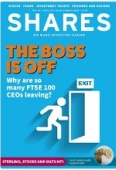Archived article
Please note that tax, investment, pension and ISA rules can change and the information and any views contained in this article may now be inaccurate.
Discount retailers could be the next losers from inflation and interest rate shock

The slump in the pound has been the big talking point for investors over the past week thanks to the market’s negative response to the new UK Government’s mini-Budget.
All those experts who had been banging the drum that UK equities were cheap may now be sitting with their head in their hands, as shares in many domestic-facing companies have become even cheaper.
Unfortunately, we’re in a situation where high inflation is proving stickier than expected, which means the Bank of England is going to have to keep on raising interest rates. Making matters worse is the fact the slump in the pound itself will fuel more inflation, as it becomes even more expensive to buy in goods and services from overseas.
Consumers will be watching every penny and businesses will be questioning their ability to fulfil short to medium-term growth plans.
Nick Clay, manager of the Redwheel Global Equity Income Fund (BMBQMY8), suggests one of the most vulnerable parts of the market could be discount retailers – precisely the type of business you might expect to thrive in tougher times such as now.
In theory, consumers under financial pressure will trade down from more expensive retailers to cheaper shops. For example, the head of discount grocery store Aldi told the BBC that people were switching to its stores ‘in droves’ as they prioritise value.
Clay doesn’t think it is that clear-cut. We’ve had two decades of cheap debt and disinflation which has enabled various low margin businesses to thrive. The surge in the cost of living and interest rates now provides a shock to their system.
‘You cannot underestimate the importance of the change in backdrop we now face,’ says Clay. ‘Target in the US and the likes of Wilko in the UK, they’re basically saying they cannot put prices up for the consumer because the whole point of their business model is to do everything cheaply. Therefore, they’re having to take the pain and the hit of cost inflation in their margins. The problem is that most of these businesses are low margin in the first place.’
The challenge for these types of companies is to ensure that sales volumes remain high, which one might expect to be helped by consumers seeking to trade down from elsewhere. ‘Unfortunately, trading down isn’t pushing up revenue fast enough to offset the fact that the cost base is increasing so margins are getting hit,’ observes Clay.
For example, Target’s (TGT:NYSE) second quarter operating income margin slumped from 9.8% to 1.2% in 2022, year-on-year. In the six months to 28 February 2022, ASOS (ASC) had gross margins of 43.1% which sounds impressive, but an already-tiny operating profit margin in the region of 6% in 2021 disappeared completely this year.
B&M European Value Retail (BME) is considered one of the cheapest places to buy everyday goods in the UK, but it warned four months ago that its earnings could fall this year as customers shied away from higher margin big ticket items at its stores, in favour of food and smaller consumer goods.
A real toxic combination in the current environment would be low margins and high debts, and that’s something we’ll look at in next week’s issue of Shares.
Important information:
These articles are provided by Shares magazine which is published by AJ Bell Media, a part of AJ Bell. Shares is not written by AJ Bell.
Shares is provided for your general information and use and is not a personal recommendation to invest. It is not intended to be relied upon by you in making or not making any investment decisions. The investments referred to in these articles will not be suitable for all investors. If in doubt please seek appropriate independent financial advice.
Investors acting on the information in these articles do so at their own risk and AJ Bell Media and its staff do not accept liability for losses suffered by investors as a result of their investment decisions.
 magazine
magazine








